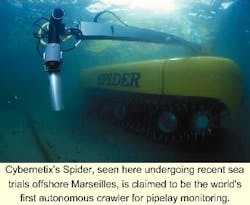SUBSEA PRODUCTION TECHNOLOGY - Survey, intervention UUVs: Where is technology headed?
Unmanned underwater vehicles (UUVs) can be broadly separated into two areas of technology: the survey class vehicle used for data acquisition; and the engineering vehicle, used for maintenance and intervention of subsea developments where traditional ROVs are presently deployed.
As the oil and gas industry moves to deeper and deeper water, the need for both vehicle types is increasingly felt, from a cost saving as well as a health, safety, and environment (HSE) standpoint. In order for the UUVs to gain rapid popularity, it will need a step-change improvement in cost, HSE and data quality compared to the current alternatives.
Survey vehicle
The unmanned survey vehicle, without its tow cable should be able to travel fast, thus collecting data quickly and cost-effectively. Auto-nomous mobility also favorably altered the HSE risk is by eliminating the exposure associated with a vehicle tied to a support vessel.
Technical integrity
There is also a question mark concerning the technical integrity of the vehicle and system analogous to an astronaut on an extra-vehicular activity. He or she is operating in a totally self-contained life support, communication, and propulsion system. But, the consequences of something going wrong are so great that the astronaut is always tethered back to the space vehicle.
With the UUVs, the implication of losing knowledge just ahead of critical decisions on a development may not kill, but could seriously wound, a project's economics. How well can we manage the risk? What recovery mechanisms exist to attempt a search and rescue of an errant vehicle? While we may take away the data umbilical, do we remain bound by the "astronaut's tether," and so never fully realize some of the big benefits?
Various estimates suggest a 10:1 leverage for expenditure on acquiring good survey data, compared to benefits through better or more accurate system development design. There is a belief that better quality data collection done more efficiently using UUVs will increase this benefit by 10-20%. However, the question will always remain: are we reaching the diminishing returns part of this curve?
Engineering vehicle
The second UUV type is the engineering vehicle for maintenance and intervention for subsea facilities. Significant growth of subsea developments is inevitable as incremental fields are connected to existing infrastructure. With this will come the need for routine and sometimes not-so-routine maintenance.
A counter-force is the emergence of a new discipline under the general banner of flow assurance. The main thrust is not only to achieve reliability of operations to an aspired level, but as such assurance is attained, to bring about fewer scheduled and unscheduled interventions. The goal remains one of designing out intervention, so it would be wrong to assume a UUV demand that exactly mirrors the mushrooming numerical growth of subsea systems.
Some imaginative minds have suggested a hybrid ROV/UUV (ROV = remotely operated vehicle), whereby a UUV is employed to take an ROV to the subsea site and "plug it in" to a docking situation that is connected, via the permanent umbilical, to the host system, such as an FPSO or TLP. This would eliminate the need for a long tether from a specialist support vessel. However, some challenges need to be addressed first. Losing one vehicle may be deemed careless; losing two, tethered to each other, could be irresponsible.
While the hybrid vehicle may offer gains in mobilization costs in remote areas, its applicability could be limited if the docking station has not been provided for in the permanently installed equipment. Also, in arenas where mobilization cost components are lower and the volume of operations attract ROVs in plentiful numbers, the competitiveness of UUVs or a hybrid solution will need to be carefully evaluated.
Summary
The UUV creates some real opportunities. Removing the need for support vehicles removes the crew and the boat itself from exposure. The lack of a tow cable for the survey vessel removes the risk of the cable parting and of the cable becoming entangled with platforms and mooring lines. Improved survey data also leads to better understanding of and response to a project's environmental impact factors.
However, as with any new product, UUVs may also introduce new risks. Oil companies expect the various equipment suppliers to understand and account for these risks. Examples could include what the new considerations should be for a safe launch and retrieval method as we alter sea state criteria for this task. Also, how do we respond to environmental concerns associated with the batteries powering the vehicles and the impact on the surrounding area if a vehicle is lost?
It will take the efforts of the oil and gas producers, working with the suppliers, to encourage use of these vehicles, thereby driving further technology development and costs down. The maintenance and intervention vehicle is still in its early conceptual stage.
Subsea and design engineers need to acquire a comfort level so that the cost of incorporating support for these vessels in their designs will provide the payoff that we would expect. To achieve this, we probably need better coordination and alignment, when viewing the timing of development and understanding of the advantages and applicability of the independent or hybrid vehicle.
We need to create the confidence that benefits in cost and contribution to flow assurance will be tangible, large, and realizable in a relatively short time frame.
Editor's Note: This is an summary version of the author's original presentation, which was a keynote paper presented at the 3rd Unmanned Underwater Vehicle Showcase Conference. The conference was held at the Southampton Oceanology Centre in the UK in September, and organized by PGI Spearhead.

